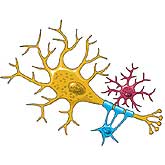Electricity and the Brain
 A child's electric train and our brains have something in common. They both require electricity for any activity to take place. But the brain uses electricity in a much different way than a toy train.
A child's electric train and our brains have something in common. They both require electricity for any activity to take place. But the brain uses electricity in a much different way than a toy train.
In 1791, Italian scientist Luigi Galvani demonstrated that electrical forces not only existed in the body, but that electricity also played a dynamic role in the operations of nerves and muscles. Galvani's experiments showed that it was possible to activate the motor nerves connected to a frog's leg muscles by introducing a mild electrical current. His conclusion that muscle movements were proof of electricity flowing between the nerves and the muscles was an erroneous deduction. However, his research took the emerging study of the electrochemical basis of neural activity and pointed it in the right direction. Galvani's astonishing discoveries inspired Mary Shelley's 1818 novel 'Frankenstein,' which served as a testament to the torrent of public curiosity in scientific research that was unleashed by Galvani's fascinating research findings.
In the early 1900's, teams of researchers confirmed the existence of electrical pulses traveling through brain cells. Today, we know that motor and cognitive functions rely on a combined electro-chemical neural process. Neurons, the 'network communicators' inside the brain, transmit messages to one another by sending electrical signals down the neuron's elongated axon. But the release of electrical signals is just the first step. The electrical signal triggers the release of neurotransmitters, which carry chemical messages to the adjoining neurons along an elaborate neural circuit. Nonetheless, the flow of electrons that we describe as an electrical current allows our brains to orchestrate walking, reading, creating and vast range of activities in the repertoire of human behavior.
About the Author
Kenneth A Wesson
 Kenneth Wesson is a keynote speaker, writer and educational consultant for pre-school through university-level institutions and organizations. He speaks throughout the world on the neuroscience of learning and
methods for creating classrooms and learning environments that are 'brain-considerate.' Ken’s articles appear in educational journals.
Kenneth Wesson is a keynote speaker, writer and educational consultant for pre-school through university-level institutions and organizations. He speaks throughout the world on the neuroscience of learning and
methods for creating classrooms and learning environments that are 'brain-considerate.' Ken’s articles appear in educational journals.


